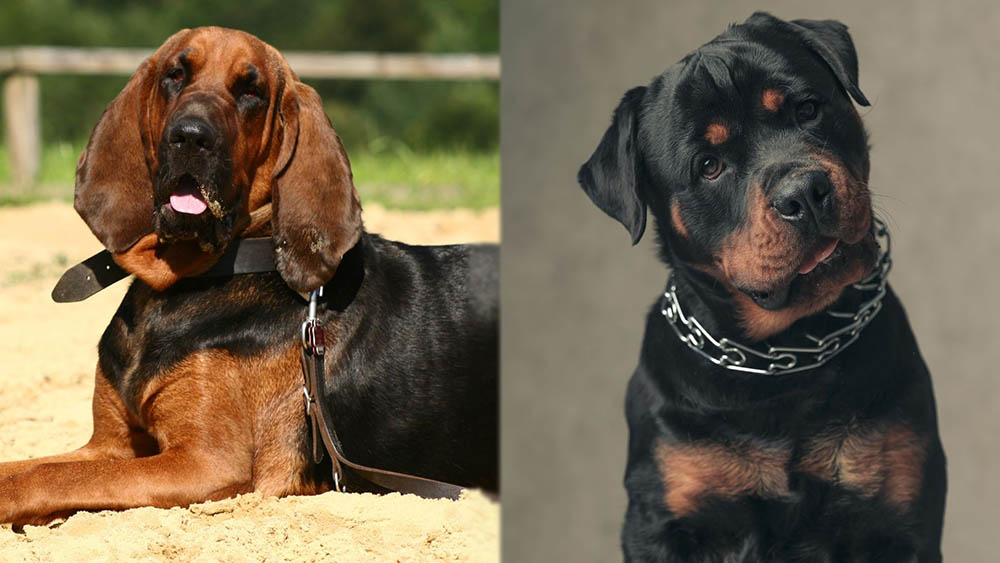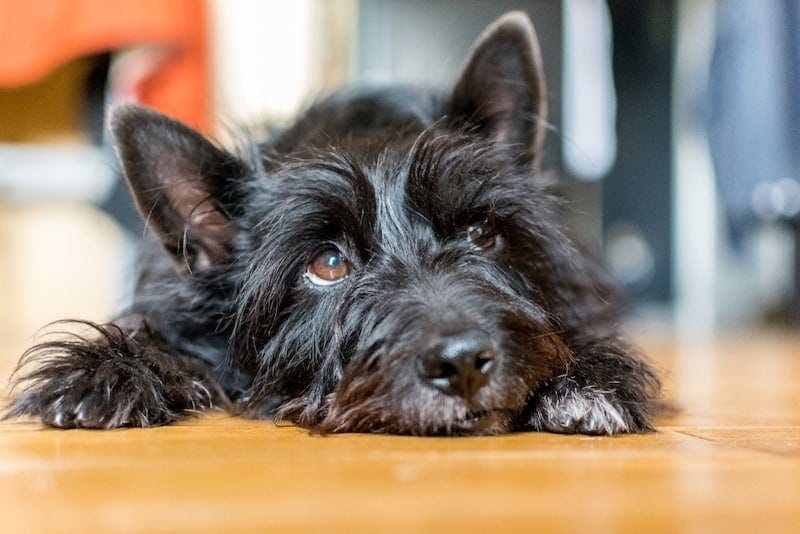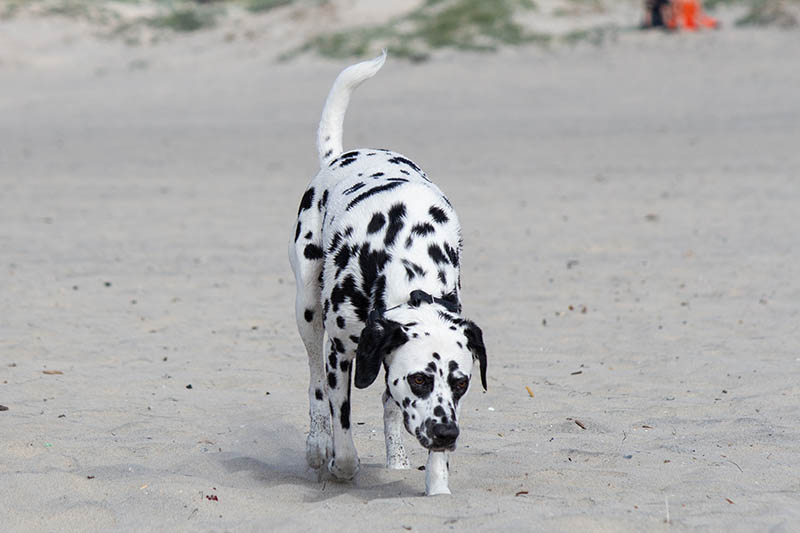Bloodhound Rottweiler Mix: Pictures, Care Guide, Temperament & Traits
Updated on

Click to Skip Ahead
The Bloodhound Rottweiler mix is a rarer mix breed that’s made by mixing a Bloodhound with a Rottweiler. They’re also known as the Rotthound or Bloodweiler, depending on who you’re talking to. They’re often strong-willed and loyal, making them best for more experienced owners.
| Height: | 23–27 inches |
| Weight: | 75–105 pounds |
| Lifespan: | 10–12 years |
| Colors: | Black, tan, red (and others) |
| Suitable for: | Active and experienced owners |
| Temperament: | Intelligent, courageous, devoted |
These dogs have a strong sense of smell and are extremely protective, making them excellent guard dogs. They’re also extremely large, weighing up to 105 pounds. Therefore, they need quite a bit of room to spread out.
They can be stubborn and prone to distraction (like a hound). However, others are easy to please. Most will fall somewhere in the middle, though it really varies from dog to dog. Luckily, they can usually be trained with great success, especially if you have experience training dogs.
For the most part, this breed is healthy. However, because they are bigger, they are prone to some health issues that come from being so big.
Bloodhound Rottweiler Mix Characteristics
Bloodhound Rottweiler Mix Puppies
Bloodhound Rottweiler puppies are typically cute and cuddly—just like all puppies. However, they are also rather big and become energetic quickly.
These dogs require early socialization and training to prevent aggression. Because they are very loyal and protective, it’s vital that they learn not everything is a sign of trouble. They also need plenty of mental stimulation from a young age to prevent boredom, which can lead to destructive behaviors.
Bloodhound Rottweiler mix puppies may be hard to find, as this is a rare and unique mixed breed. However, you may be able to locate a breeder producing these puppies or find them at a rescue. Specialty rescues focusing on either parent breed tend to be the best bet.
Often, you can expect to pay $500 to $2,000 for a puppy when purchasing from a breeder.

Temperament & Intelligence of the Bloodhound Rottweiler Mix
The Bloodhound Rottweiler mix is loyal and protective, making them excellent guard dogs. They are extremely devoted to their owners and can be extremely watchful. They’re great with children when socialized properly and can be affectionate with those they’re close to.
This mix tends to be very intelligent and can be eager to please. However, they may be stubborn at times due to their hound blood. They can often learn new commands easily, but that doesn’t necessarily mean they’ll listen in real-world situations.
Because of this potential stubborn streak, we only recommend them to experienced dog owners. They do best with someone that has trained dogs successfully in the past.
Due to their Bloodhound heritage, they have very strong noses that they will follow anywhere. Therefore, it’s important to always keep them in a secure area or on a leash. Otherwise, they’re prone to getting lost.
Socialization is vital for this breed, as it helps prevent aggression.
Are These Dogs Good for Families? 👪
These dogs often work great in families as long as they are properly socialized from a young age. They are great with children and can be a good guard dog for a family. They are naturally protective, which can be a good thing and a bad thing.
However, they aren’t a good fit for every family. They are large, energetic dogs, so they do best with active families with plenty of room. They may also drool quite a bit, which may be off-putting for some.
Once again, we recommend these dogs for experienced dog owners, as they can be stubborn and independent at times.
Does This Breed Get Along with Other Pets?
This mixed breed can get along well with other pets if trained and socialized properly. They can be very tolerant of other animals but do require socialization beforehand. Otherwise, they may see the other animal as a threat, leading to aggression. As we’ve stated, socialization is absolutely vital for this breed.
They also have a bit of a prey drive, so they don’t do best with smaller animals. However, they can get along with cats and dogs when introduced properly.
The Bloodhound Rottweiler mix needs supervision and control when around other pets, especially if they are not well-socialized or if they are in situations that trigger their protective or prey drive. Always introduce them gradually to other pets and new animals.
Things to Know When Owning a Bloodhound Rottweiler Mix:
Food & Diet Requirements 🦴
The Bloodhound Rottweiler mix is a big, active dog that requires a significant amount of food. Be sure to choose a quality diet and monitor their intake. While they aren’t particularly prone to obesity, they are already very big dogs. Putting on extra weight can only make them more prone to joint problems.
Always follow the nutritional guidelines on the back of the bag. However, some dogs may need more or less than the “average,” especially if they are particularly active (or inactive). For very active dogs, a higher-calorie food may be needed. Extra protein is often necessary for dogs that are very engaged in protection or tracking work. They need it to repair their muscles.
Most of the time, these dogs don’t have special dietary needs. However, if your dog does, it’s important to work with your vet to meet them. You may need to avoid particular allergens that your dog is sensitive to or look for food with added joint support.
Exercise 🐕
These dogs tend to have medium to high energy needs, which often translates into lots of exercise. They need at least an hour a day to remain happy and healthy, with some dogs needing significantly more than this. Often, these dogs need moderate to intense exercise, so they do best in an active family.
You can engage these dogs in many different activities to help them exercise enough. Hikes, walks, playing fetch, tracking, and hunting are all suitable options. Try to engage their body and their mind, which can help the activity pull double duty.
The Bloodhound Rottweiler mix needs a fenced-in yard or a dog park where they can run and play safely. Of course, ensure they’re well-socialized before putting them in a situation with other dogs.
Of course, avoid overexercising these dogs, as this can lead to joint issues. Puppies in particular should be exercised with caution. Often, these dogs will push themselves further than they need to go if they think that’s what their owner wants.
Training 🎾
Bloodhound Rottweiler mixes are intelligent and eager to please—usually. These traits help them learn new commands quickly and perform them properly in real-world situations. You can train them to perform a variety of tasks and tricks, including tracking and protective work.
However, they can also be extremely distractable, especially when scents are involved. They may also be stubborn, especially around maturity. Therefore, they are best for experienced dog owners who can work through these tougher periods.
While these dogs are protective, they aren’t necessarily aggressive. When properly socialized and trained, they shouldn’t unnecessarily bite or growl at anyone.
Your mixed breed should be taught all the basic commands, such as “sit” and “stay.” However, you should also work hard on recall commands, as this can prevent them from becoming lost if they get stuck on a scent.
Grooming ✂️
The Bloodhound Rottweiler mix has some grooming needs, depending on their coat type. These dogs often shed considerably, so you’ll need to brush them to remove this excessive fur. Luckily, their fur is shorter, so it doesn’t make quite as big of a mess as some other breeds. If you aren’t okay with a little dog fur, though, this breed isn’t for you.
Plan on brushing these dogs every other day during most of the year. During the spring and fall months, these dogs may shed even more, and you may need to bump up your grooming sessions to every day. Just keep an eye on your dog’s coat and adjust as needed.
The Bloodhound Rottweiler mix may also need occasional bathing to keep them clean and smelling fresh. They may produce lots of drool, which requires regular wiping. If they have wrinkled skin, you may need to clean their wrinkly areas regularly, as this helps prevent bacteria buildup and skin infections.
Of course, these dogs also need their nails trimmed, ears cleaned, and teeth brushed. These basic grooming tasks are necessary for all dogs. However, this mixed breed needs extra attention paid to their ears, which may be prone to infections.
Health & Conditions 🏥
The Bloodhound Rottweiler mix may have some health issues that are common in large breeds or that are inherited from their parent breeds. However, because they are a mixed breed, they tend to be quite healthy.
For the most part, they’re prone to hip dysplasia and elbow dysplasia due to their larger size. Both of these conditions affect their mobility and can cause pain at a very early age. You may want to choose a food that’s specifically designed for larger dogs, as they often include joint-supporting ingredients.
These canines are also prone to bloat due to their deep chests. This condition is life-threatening and occurs fairly quickly. Emergency surgery is often needed to correct it. Sadly, we don’t know exactly what causes it.
Based on their parent breeds, these canines may also be prone to eye issues, like entropion and ectropion. These conditions cause the eyelid to roll inwards or outwards, causing infection and irritation. Often, surgery is necessary to correct the eyelid.
If they have wrinkly skin, these dogs may also be prone to infections. Often, this occurs when bacteria find their way into the folds. Therefore, basic grooming can help prevent this problem.
- Eye problems
- Skin infections
- Hip & elbow dysplasia
- Bloat
Male vs. Female
Male Bloodhound Rottweiler mixes may be larger and heavier than female ones. They may weigh anywhere from 90 to 110 pounds, while females may weigh from 80 to 100 pounds. They may also be taller, with males reaching up to 26 inches and females up to 24 inches at the withers.
However, these dogs vary so much (because they are a mixed breed) that differences may not be so obvious. Some females will be bigger than males, for instance.
These dogs don’t have any temperament differences between genders. For the most part, their temperament will be shaped by their genetics and how they are raised. However, males and females may experience temperament changes due to hormones.
Of course, there are obvious biological differences, too. This means that females will go through a heat cycle if not spayed, while males will not. Males may be more likely to wander off if they small an in-heat female, though.
3 Little-Known Facts About the Bloodhound Rottweiler Mix
1. The Bloodhound Rottweiler mix is rare.
While some mixed breeds have become more popular over the last few years, the Bloodhound Rottweiler mix doesn’t fall into that category. This breed is rarely produced by breeders, which makes it difficult to find.
2. They can vary a lot.
As a mixed breed, you never exactly know what traits a particular puppy will inherit. Therefore, if you’re looking for a very particular dog, you should look elsewhere. You’re playing a game of chance with this breed.
3. They have a very good sense of smell.
This mixed breed has one of the best senses of smell of any breed thanks to their Bloodhound ancestor. However, because they aren’t 100% Bloodhound, their nose won’t be quite as good as it could be.
Final Thoughts
The Bloodhound Rottweiler mix is a considerably rare mixed breed that’s known for their protective instincts and sense of smell. They’re a purpose-driven dog, first and foremost. They are extremely protective of their family and devoted to their owners. They are often easy to train thanks to their loyalty.
However, they do vary quite a bit, as they can inherit any trait from either parent. Some may be more likely to follow their nose than others, for instance.
While these dogs can make great family pets, they do require a lot of work. They need to be brushed very often, as they shed a lot. They also require a lot of training and socialization to keep their protective instincts in check. Their exercise needs are high, as well, so they do best with an active family.
Featured Image Credit: (L) Sabine Hagedorn, Shutterstock | (R) Viorel Sima, Shutterstock













